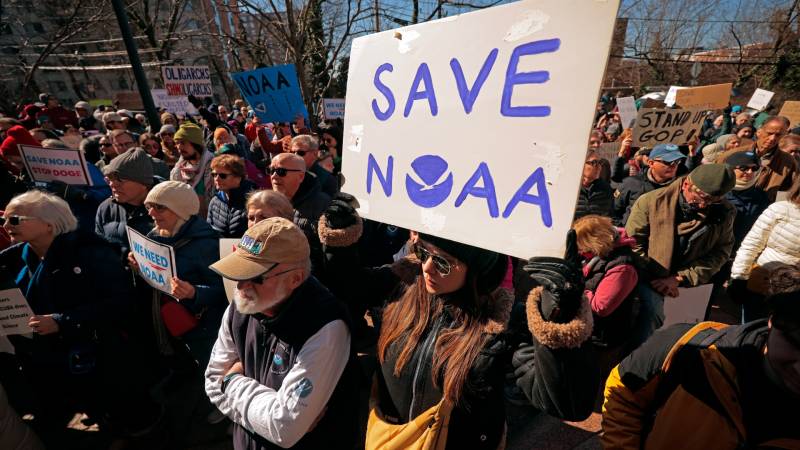Scientists who study and keep the public informed about wildfires, hurricanes, avalanches and climate change are reeling from the Trump administration’s mass firings at the National Oceanic and Atmospheric Administration, which includes the National Weather Service. We talk to climate scientist Daniel Swain about the essential work NOAA does in California and nationwide and the impacts of the firings on public safety and mission-critical scientific research. Tell us: Are you affected by the NOAA layoffs?
Are You Affected by the NOAA Layoffs?

Guests:
Daniel Swain, climate scientist, University of California Agriculture and Natural Resources & UCLA Institute of the Environment and Sustainability
Heather Welch, terminated research biologist at NOAA Fisheries who worked on the NOAA Climate, Ecosystems and Fisheries Initiative in Monterey, California
Kayla Ann Besong, terminated duty scientist for NOAA’s Pacific Tsunami Warning Center in Honolulu, HI
Show Highlights
The Role and Responsibilities of NOAA
NOAA’s work is vast and essential, says climate scientist Daniel Swain. Beyond issuing severe weather alerts, NOAA monitors tsunamis and wildfires, manages fisheries and provides critical data that safeguard both lives and the economy.
“NOAA is explicitly acting in the interest of the American people,” Swain says.
Mass Terminations Under the Trump Administration
In recent weeks, more than 880 NOAA employees have been laid off, including scientists responsible for weather predictions, extreme weather warnings, and climate change research. The terminations were abrupt and disorganized, with little notice or explanation given to staff.
Kayla Ann Besong, a former duty scientist at NOAA’s Pacific Tsunami Center, learned of her termination through an email—before her supervisor even knew. “Some supervisors still haven’t been informed,” she says. “If we hadn’t told them, they wouldn’t know.”
Impacts on Weather Forecasting and Public Safety
The layoffs have already disrupted critical forecasting tools, including weather balloon launches and other data-gathering systems.
With more cuts expected, Swain warns of dire consequences: “The next time there’s a major extreme weather event, there simply won’t be enough personnel available to fill all the needed roles.” This could mean delayed or missing warnings for tornadoes and flash floods, putting lives at risk.
The Economic Price of Cutting NOAA
NOAA’s work drives economic efficiencies across sectors like aviation and agriculture. “The return on investment is at least ten to one,” says Swain. “For every dollar spent, there’s a ten-dollar gain.” Its data helps businesses minimize losses and maximize productivity.
A listener says, “A little bit of money saved on NOAA salaries means higher food prices, fewer food choices, more failed crops, more crops not planted. It’s a bad deal for all of us.”
Challenges in Privatizing NOAA’s Functions
The Trump administration has proposed privatizing NOAA’s functions, but experts question the feasibility of this approach. “The private weather sector couldn’t operate without NOAA because it wouldn’t have any basic data to work with,” Swain says. While private-public partnerships have potential, he calls the idea that the private sector could fully replace NOAA “a complete misunderstanding.”
Personal Experiences of Terminated NOAA Employees
The human toll of the layoffs is clear in stories like that of Heather Welch, a former NOAA research biologist focused on climate and fisheries. “I had to walk away from years’ worth of work,” she says, “with no clear plan for how it would be managed or who would continue it.”
Carly, a biologist hired to fill staffing gaps at NOAA, was shocked by the reasoning behind her termination. When she joined, there was a significant backlog of hatchery genetic management plans, essential for managing fish production in hatcheries. Her role was to collaborate with hatchery managers to ensure fish production met targets that support both inland and ocean fisheries, helping sustain the U.S. fisheries economy. “My termination letter says the agency no longer needs my skills and abilities,” she says. “Which is in direct contrast to why I was hired.”
While the underlying motivations behind the mass terminations at NOAA may stem from ideological differences or a desire for cost-cutting, the real-world impacts could be severe.
Swain says, “What’ll be a shame is if we lose hundreds or even thousands of people with very specialized expertise—experts dedicated to preventing harm and providing public benefits—who, through no fault of their own, are forced to find other jobs that don’t fully utilize their skills. In turn, the public loses out on the benefits those experts would have provided in their dedicated roles as public servants.”
This content was edited by the Forum production team but was generated with the help of AI.